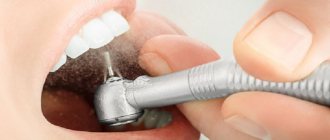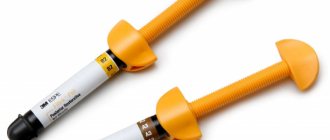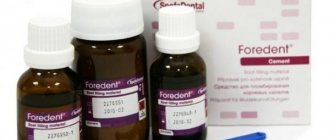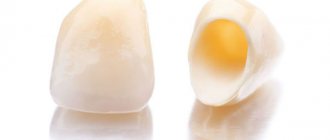Indications for placing a temporary filling
- Treatment of deep caries. After cleansing the tooth cavity from necrotic masses, the dentist places a medicinal solution that helps the dentin strengthen the layer between the pulp chamber and the open cavity.
- Diagnosis of the condition of the tooth with deep caries before installing a permanent filling.
- Acute pulpitis. A temporary intermediate composition is placed while the nerve is removed.
- Periodontitis. To relieve inflammation, an antiseptic or medicinal preparation is placed in the area of the tooth roots, which is then covered with light cement.
- Sanitation of dental canals before filling. The doctor cleans the canals, filling them with a disinfectant solution, then places a temporary filling.
- Prosthetics, restoration. The process of making an artificial crown or orthodontic structure takes several days. To protect against microbes, the open tooth cavity is closed with a temporary filling material.
Stages of placing a temporary filling:
- opening the tooth cavity, removing all affected dentin tissue;
- expansion, cleaning, treatment of dental canals;
- therapeutic stage (depending on the diagnosis, the nerve endings of the pulp are removed, medications are placed in the tooth cavity, and the canals are filled with temporary cement);
- The crown is closed with a temporary filling.
Content:
- Why are temporary fillings placed?
- Why use it - indications for use
- How long can you walk with such protection?
- Manufacturing materials
- How does the installation work?
- Rules of care
- If the coating collapses prematurely
- How does the replacement work?
Often, patients at dental clinics are faced with a situation where the doctor gives them a cheap intermediate filling and indicates the day when they need to come back for a follow-up appointment to replace it with a permanent one. We suggest you understand this treatment tactics and its features.
Material of manufacture
Requirements for temporary filling materials:
- no toxic effect on tooth structures (enamel, dentin, pulp) and mucous membranes of the oral cavity;
- safety for human health;
- chemical inertness and high resistance to saliva and aggressive environments (alkalies, acids);
- mechanical strength, wear resistance, ductility;
- lack of galvanization effect;
- maintaining shape and size during hardening;
- good radiopacity.
The choice of material for a temporary filling depends on the clinical case, age, individual characteristics of the body (the presence of allergies to certain substances), as well as how long the patient will wear it.
How does the replacement work?
When the medicine under the protective “barrier” stops working, a permanent filling is installed. Using a drill, the doctor removes the remaining temporary material. Then it carries out antiseptic treatment of the opened tissues. Makes sure there are no complications and then places the permanent material.
All manipulations are carried out in one visit to the doctor. They are usually comfortable and do not require the use of painkillers - after all, the inflammation has already been cured and the nerve has been removed.
Intermediate filling materials
- A paste based on zinc sulfate and kaolin allows you to restore the crown of the tooth.
- Karyosan has an analgesic and antiseptic effect.
- Vinoxol is an artificial dentin. Withstands chewing load for up to 1-2 months.
- Cement with zinc and eugenol. It is used for antiseptic treatment of tooth tissue and relief of the inflammatory process.
- Glass ionomer cement is used for temporary fixation of the prosthesis.
- One-component polymer materials are pastes with a viscous consistency that harden under the light of a special lamp.
If the coating collapses prematurely
It happens that one day a person notices that the carious cavity is left without protection. No need to panic. The fact that a diseased tooth is open to invasion by pathogenic microflora is bad, but it is easy to fix. You should immediately visit your dentist to have it refilled.
If for some reason it is impossible to do this, and the visit has to be postponed by several days, you should monitor the condition of the “hole” and ensure that food debris does not collect in it. See your doctor as soon as possible.
Under no circumstances should you close an open cavity with chewing gum, gauze, cotton wool or other improvised means. These measures will worsen the situation - they will increase the likelihood of infection entering the deep tissues of the tooth.
How long does it take to wear a temporary filling?
Depending on the material of manufacture, a temporary filling has different characteristics of strength and tightness and can last from several days to six months.
Average duration of use of a temporary filling:
- 2-3 days, if a drug is placed under the filling that destroys the nerve endings of the pulp;
- 7–10 days while treatment of the inflammatory process with periodontitis or pulpitis continues;
- 2-3 weeks - for the period of manufacture of the orthopedic structure;
- several months in special diagnostic cases (when treating a dental cyst, restoring dentin after deep caries).
It is necessary to strictly adhere to the timing of wearing temporary fillings. If the time period is extended, its integrity and sealing may be compromised, which will negatively affect the health of the tooth. Thus, arsenic-based paste, if not removed after 2-3 days, begins to penetrate the dentin through the tubules, destroying bone tissue.
How long a temporary filling can be worn is decided by the attending physician, depending on the diagnosis and the chosen treatment method.
Removing a temporary filling is a mandatory procedure before placing a permanent filling. After removal of the temporary composite, antiseptic treatment of the root canals and dental cavity is carried out. Next, a permanent filling is installed.
Precautionary measures
In order not to bitterly regret the time spent in the dentist’s office, after installing a temporary filling, it is highly advisable to follow the following simple rules:
- When brushing your teeth, especially if the filling has been installed for a fairly long period of time, use a brush with soft bristles. Otherwise, oral care is carried out as usual: brushing 2 times a day, you can use rinses.
- Try not to chew on the affected side of your mouth, and temporarily avoid sticky toffees, chewing gum, hard nuts, bones and candy. Do not put pressure on the tooth while testing the strength of the filling.
- Within 1 day after installation, it is not advisable to eat beets, drink coffee, tea, or red wine, as the filling may become stained.
- Toothache will be relieved by rinsing with chamomile and sage decoctions, an aqueous solution with sea salt and soda. As for painkillers, it is better to consult a doctor. Aspirin should be avoided: it is ineffective against toothache, and in large quantities it harms the stomach.
- The most pressing question that arises after a temporary filling has been installed is: when can you eat? Modern reflective fillings harden almost instantly, meaning you can eat food within 20 minutes. But this is theoretical, but in practice it is better to clarify this point with the dentist. In most cases, you can safely eat and drink 2-3 hours after filling.
It is important to remember that the highest quality temporary filling is not a suitable replacement for a permanent one, so you should not delay your visit to the dental office.
Problems that arise when installing a temporary filling
Painful sensations can be caused by an incompletely destroyed nerve, infection under the filling, or the development of inflammation.
The filling falls out or crumbles. If you do not immediately consult a dentist, the treatment will have to begin again with re-sanitation of the canals, treating them with antiseptics to stop the development of infection.
An unpleasant taste in the mouth often indicates depressurization of the temporary coating, when the medicine from the tooth begins to leak into the oral cavity.
Darkening of the filling, swelling or redness of the gums may be signs of an allergic reaction to a component of the filling material.
How does the installation work?
Since the composition is intermediate and is laid down for a specific purpose, it is logical that its use is preceded by certain preparatory manipulations:
- The doctor cleans the affected area using a drill and medical instruments. He carefully removes the remnants of altered tissue to prevent further destruction of the crown.
- Then it processes the channels. There are two options here - either the nerve is removed immediately, followed by washing the roots with an antiseptic, or a medicinal mixture is applied.
- A filling is placed on top, which will soon be replaced.
- Before letting the patient go, the dentist tells you how to care for the tooth , when to come next time, and what to do if the mixture falls out prematurely.
What determines the maximum wearing period?
The maximum wearing period is determined by the dentist individually.
The maximum period of wearing a temporary filling depends on several factors:
- method of treatment;
- type of filling material used;
- means for filling into the tooth cavity.
The drilled hole may not reflect the full picture of the disease or may require further placement of medication. A temporary filling in this context serves as an auxiliary diagnostic function.
Short-term operation of the insert requires high-quality installation of the filling mass with hermetically sealed closure of the cavity in the tooth. This will ensure reliable fixation of the embedded drug and prevent food particles from penetrating inside. Previously, to suppress the sensitivity of the nerve, arsenic was inserted into the cleaned tooth hole. At the same time, the filling could not be kept for long and had to be replaced after 72 hours.
Modern dentists prefer to use other drugs, which increases the period of wearing a filling insert from 5 days to 3 weeks . If the patient needs long-term treatment, then reflective material is used as medical cement (lasts from 3 to 6 months).
Which filling is better?
Given the variety of filling materials, their different characteristics and the need to match the filling to the individual characteristics of the patient, it is obvious that only a doctor can make the best choice. But the patient has the right to take part in the selection of fillings, weighing the pros and cons of each type of material, focusing on its cost. It is necessary to take into account the possible negative consequences of your choice if you refuse the material strongly recommended by the dentist, since only a doctor can correctly assess all the features of the treatment. Trust your dentist!
What care do fillings require?
Filled teeth do not require any special care, but we must not forget that you need to brush them, regardless of whether they have fillings or not, at least twice a day and very carefully. Dentists also recommend attending professional oral hygiene procedures at least once every six months. In this case, the hygienist should grind existing fillings and pay special attention to them.
You also need to remember that filling material is still more porous than enamel, so it absorbs pigments from coloring foods and drinks more strongly. That is why, immediately after caries treatment, it is not recommended to eat beets, red berries and similar foods for several days, especially when it comes to the front teeth.
Light-curing filling: advantages and installation features
A more accurate name for this dental composite material is photopolymer filling. The prefix “photo-” indicates that special light is needed to cure the filling, and polymers are composite materials.
A light filling gives the dentist the opportunity to accurately reproduce a full-fledged tooth, because, unlike a cement filling, it hardens only under the influence of a lamp. However, it is worth remembering that over time, even the best light-curing filling will darken or become noticeable at the border with the enamel. Therefore, and also because it may fall out at the end of its service life, the structure requires timely replacement, on average, once every five years. As for installing fillings on the front teeth, modern dentistry suggests using ceramic inlays instead. They are better, imitate natural tissues, last longer and are practically invisible on the teeth even after several years.
Let's take a closer look.
Endodontic treatment, or root canal treatment , is a long-term procedure that involves removing non-viable nerves and pulp from the tooth. This treatment method is indispensable in dentistry and can significantly extend the life of the tooth in diseases such as pulpitis, periodontitis, etc.
For endodontic treatment, our clinic uses a dental microscope, which allows us to greatly enlarge the canals of the tooth and not treat blindly.
Fillings for baby teeth
Until recently, only glass ionomer cement fillings were used for primary teeth. Now light-curing composite fillings have come to the fore.
A new product in pediatric dentistry is colored fillings made from glass ionomer cement with the addition of a hybrid composite. The fillings have the following characteristics:
- Plasticity, ease of working with them for the dentist.
- High degree of adhesion to hard tooth tissues.
- Constant release of fluoride into the tooth tissue, which protects it from caries.
- Affordable price.
- The service life is 3-4 years, which is enough to replace temporary teeth with permanent ones.
The ability to choose the color of the filling yourself makes visiting the dentist interesting and relieves psychological stress in the child. After treatment, children enjoy caring for their “new” teeth and do not refuse to come to the doctor for preventive examinations.
Types of materials for dental fillings
Dental clinics today use various filling compounds. More information about the names of fillings and materials used can be obtained directly from your doctor. Filling materials are made based on the following components:
- Amalgam. A metal filling compound that is strong and durable. Quite rarely used in practice. The advantages include strength and abrasion resistance. The disadvantages are unaesthetic and the risk of developing allergies. There are contraindications.
- Cement. The main material for chemical fillings. The most commonly used powder is zinc oxide with the addition of silicon and magnesium. The advantages are affordable cost, ease of installation, and reduced risk of developing recurrent caries. The downside is quick erasing and poor aesthetics.
- Plastic. Composite product for durability and reliability. The best option when you don’t know what filling to put on a tooth and have a limited budget. Compositions based on acrylic acids are especially popular. They are distinguished by good durability and the ability to select colors. The downside is the high risk of microscopic pores.
- Photopolymers. Light-curing filling materials are the most popular today. The paste mixture hardens under the influence of ultraviolet light. The advantages are natural shine, strength, aesthetics, minimal toxicity. A light seal made of photopolymer material is practically free of disadvantages.
- Composites. Plastic products with special inorganic fillers. Among them is a gutta-percha filling. It is distinguished by strength, indelibility, and resistance to external factors. Used as a filling material for root canals.
- GIC (glass ionomer cements). High-strength filling material used for fixing crowns. Has excellent adhesion to metal and ceramic products.
More information about glass ionomer and light-based fillings can be obtained directly from your dentist. The choice of filling composition must be approached responsibly and trusted by your attending physician, since the performance of the chewing function will depend on this. At our AlphaDent dental clinic you can get detailed advice on selecting the necessary filling to suit your individual characteristics.








